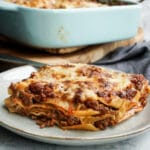
In the central and northern regions of Italy, Lasagna is simple and only made with Bèchamel (white sauce), Ragù (Bolognese sauce), pasta, and Parmigiano cheese. Quite different from the loaded Lasagna of southern Italy, but no less delicious! If you're ambitious and want to make everything from scratch, you'll find all the instructions and tips in this recipe.
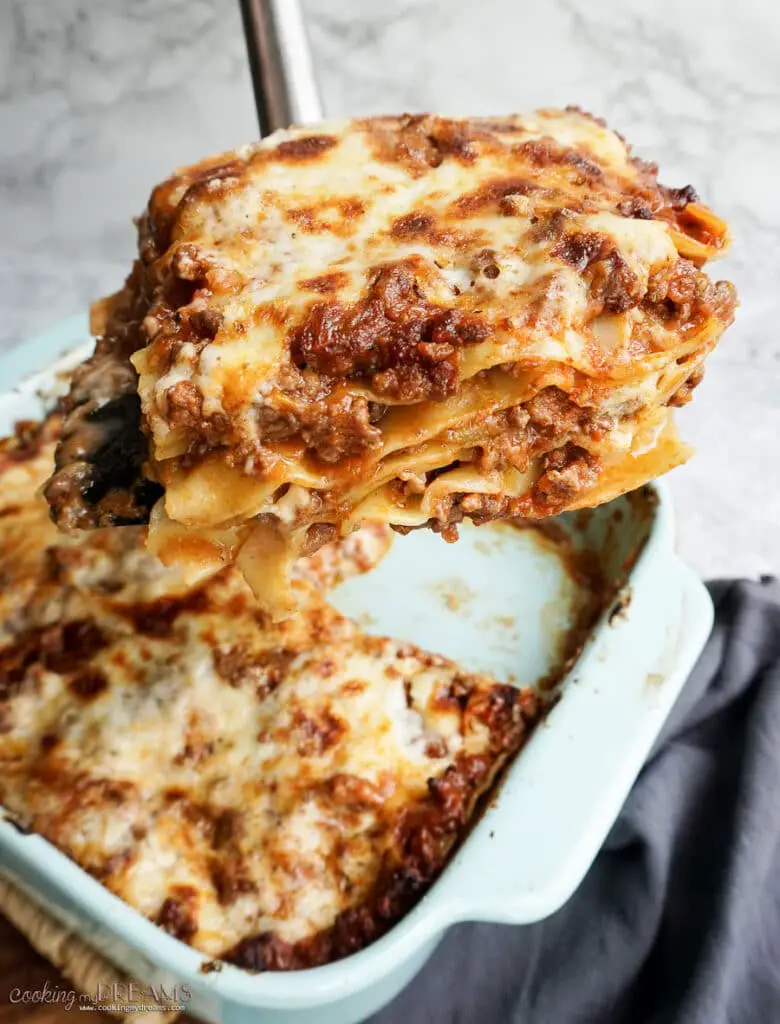
I call this recipe "Tuscan Lasagna" for the simple reason that I was born and raised in Tuscany and this is how we traditionally make Lasagna. But the same recipe is also used in many other regions of central and northern Italy.
Americans are used to the loaded Lasagna recipes from Italo-Americans who are usually immigrants from the south of Italy. Especially from Naples, where every food is loaded and comforting. In the South, it is common to make Lasagna with Ricotta and little meatballs. But in northern regions, recipes are more simple and Lasagna usually has nothing more than Ragù sauce, Parmigiano, and Béchamel sauce.
Jump to:
Ingredients and Substitutions
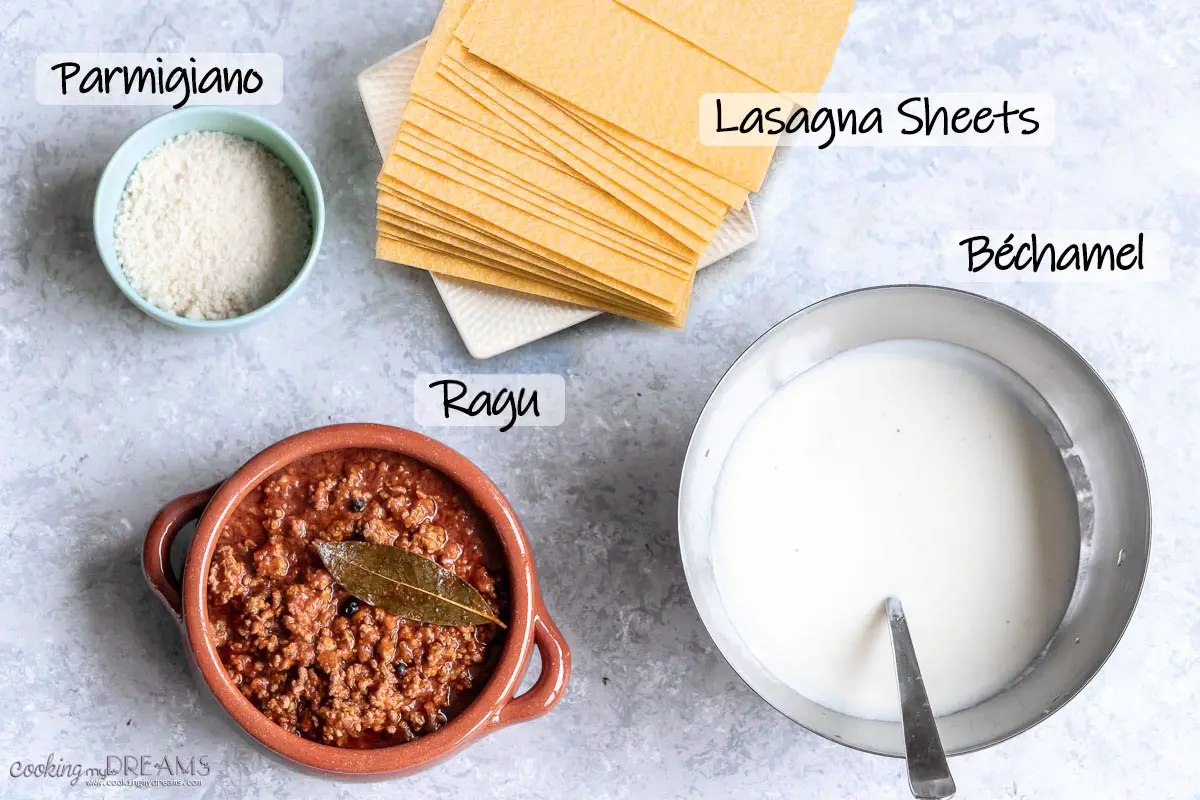
- Tuscan Ragù. As the name suggests, Tuscan Ragù is essential to making an authentic Tuscan Lasagna. The difference between Tuscan and Bolognese Ragù, is that the Tuscan one is more saucy and has a distinct flavor thanks to the juniper berries.
- Béchamel sauce. Béchamel or white sauce is the second most important ingredient in the Lasagna made in Northern Italy, which differs from the Southern one which has much more cheese and meat in it.
- Pasta. You have 3 options: homemade fresh pasta, storebought fresh pasta, or dried packaged pasta. I usually prefer the latter as it gives the best consistency and flavor, but feel free to choose the one most convenient to you, the recipe and cooking times will not change.
Substitutions & Variations
- Vegetarian: You can substitute the ground meat in the ragù with vegetarian ground to turn this into a vegetarian Lasagna.
- White: Skip the tomato sauce and add some heavy cream to the meat sauce to make it a white Lasagna.
- Cheesy: Add pieces of Mozzarella, or other cheese like Gorgonzola, or Provolone, between the Lasagna layers for a cheesier version.
- Packed with veggies: Add some chopped zucchini, bell peppers, eggplant, broccoli, and more to the ragù to give it a veggie boost.
- Gluten-free: You can substitute the pasta sheets and béchamel with gluten-free versions.
- Spicy: Add some chili pepper flakes to the ragù to make it spicy.
The difference between fresh and dried pasta sheets
I have to admit that I rarely make fresh pasta when I make Lasagne. The main reason is fresh pasta cooks in just a couple of minutes so it will come out inevitably overcooked in a Lasagna, unless you let the pasta dry for a few hours, which makes the process even longer.
The upside of using fresh pasta is that you can choose the thickness if you prefer many thin layers or less thick ones. You can also cut the sheets to the perfect size for your pan, which is great, since the dried pasta never ever fits any pan shape or size. Ever.
In big supermarkets, you can also often find fresh Lasagne sheets in the fridge. They are a good compromise between dried pasta and homemade fresh ones.
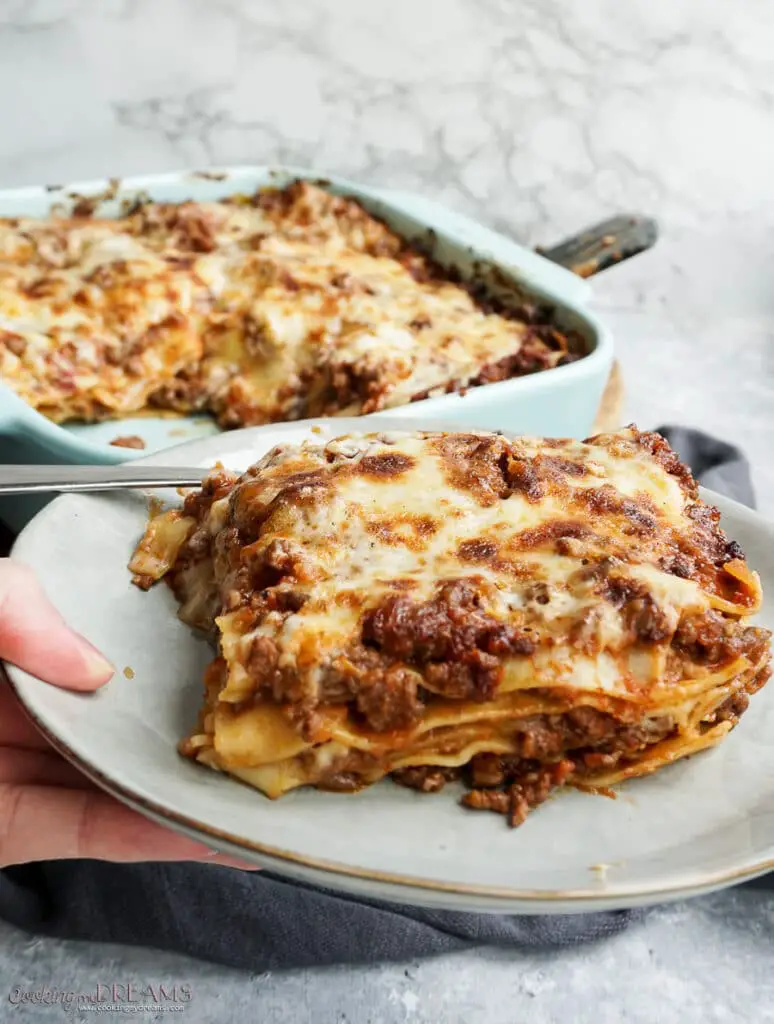
How to make Lasagna
The most difficult part of Lasagna is getting all the elements ready: making the pasta, the Ragù, and the Bechamel sauce. Once you have everything ready, comes the fun and easy part: the assembly of the layers!
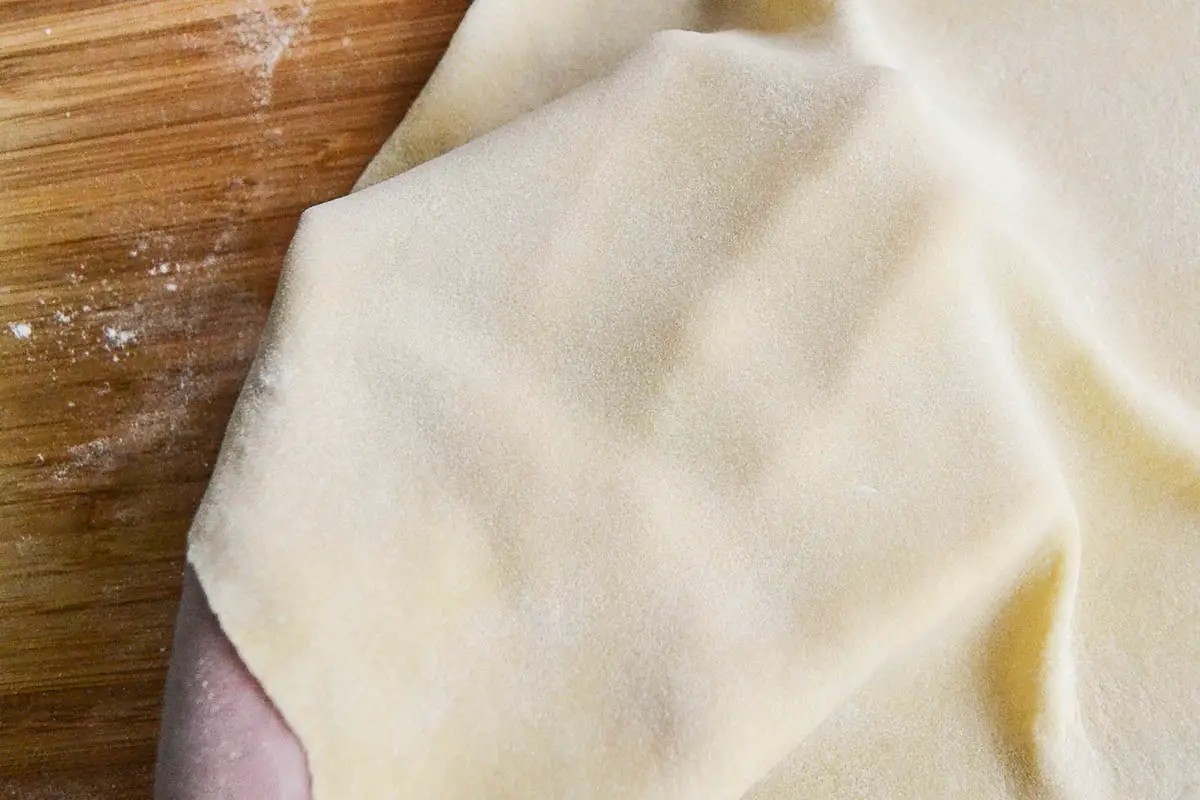
Make the Pasta: If you choose to make homemade fresh pasta for your lasagna, you should make about 3-4 portions, depending on how thin you're stretching it. Start with 4 portions, if it's too much you can still freeze the leftover pasta.
- Check this recipe to make fresh pasta from scratch.
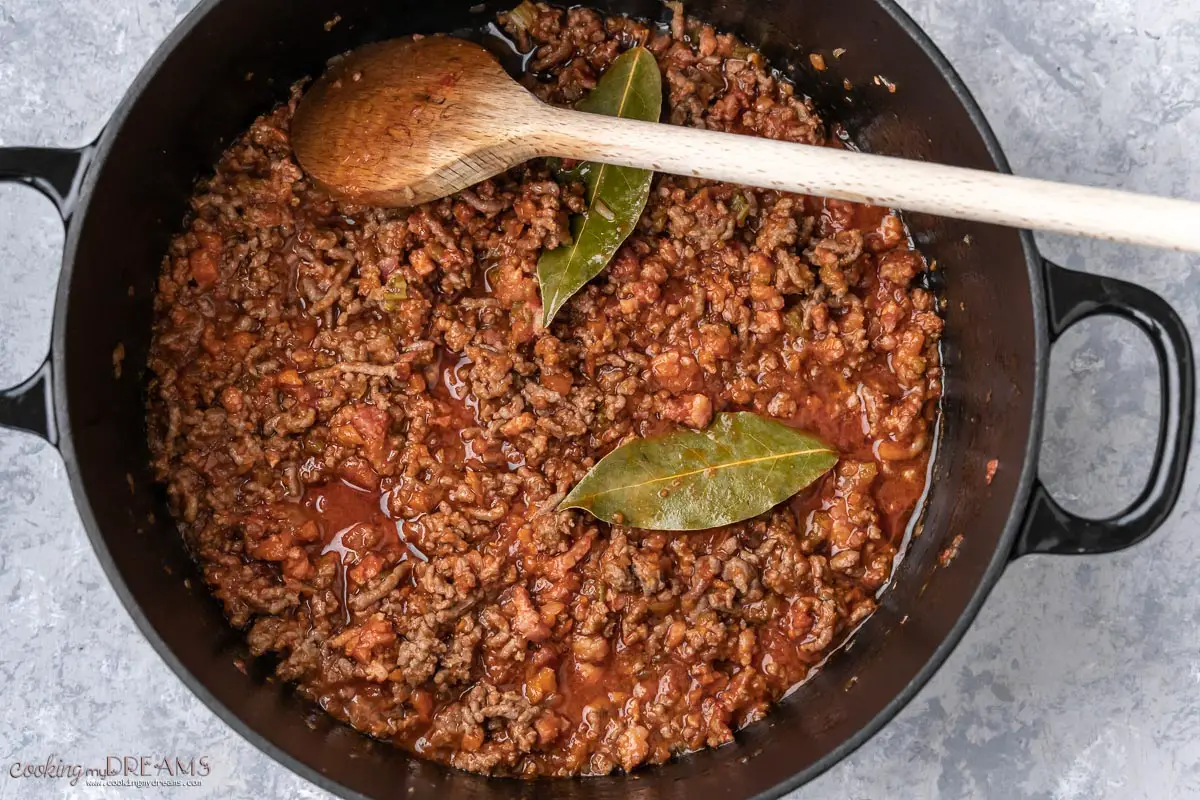
Make the Ragù: Ragù is the Italian name for Bolognese sauce, as Bolognese is just one of the many varieties of Ragù. I always make my Tuscan Ragù sauce, the way my family always did it. It takes a couple of hours to make so I would suggest making it the day before or early in the morning if you want to bake your Lasagna for lunch.
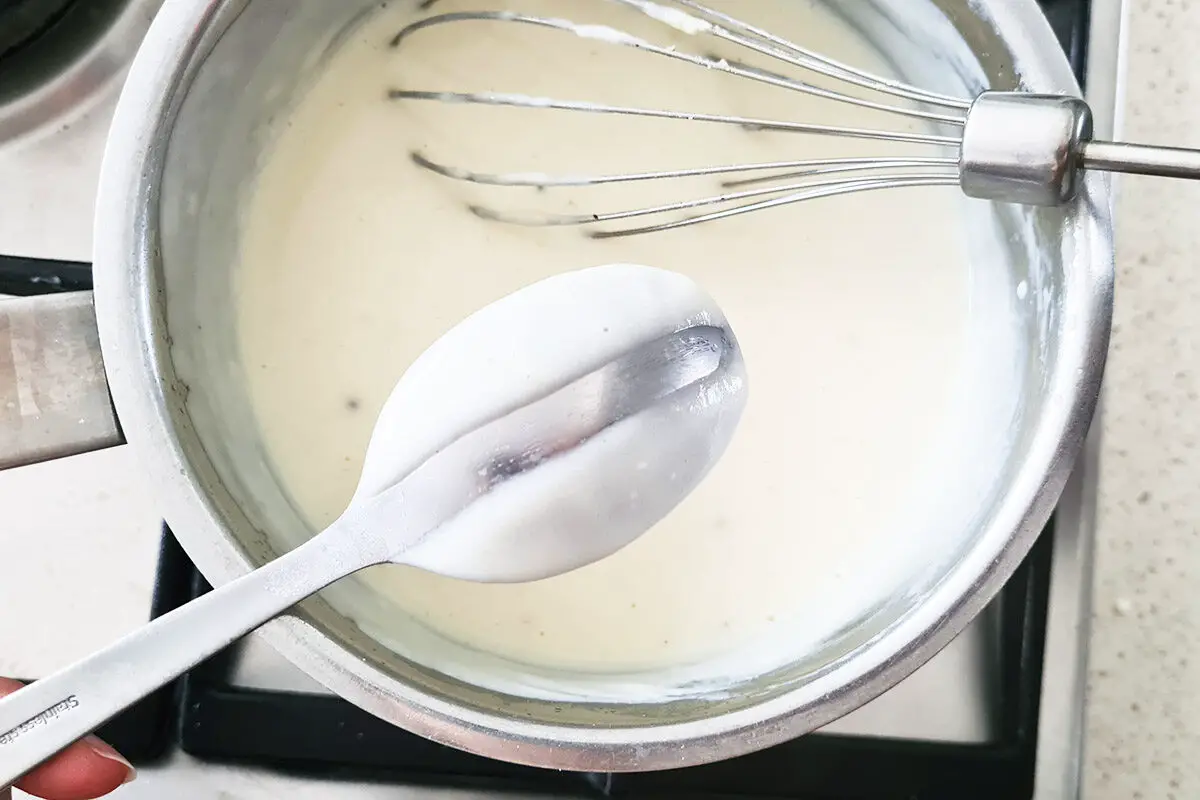
Make the Bechamel: Béchamel or white sauce is very easy to make. So easy that I never buy the jarred one which is full of useless ingredients and preservatives. You only need butter, flour, and milk. It takes about 10-15 minutes to make and you can also make it in advance and keep it in an airtight container in the fridge for a couple of days.
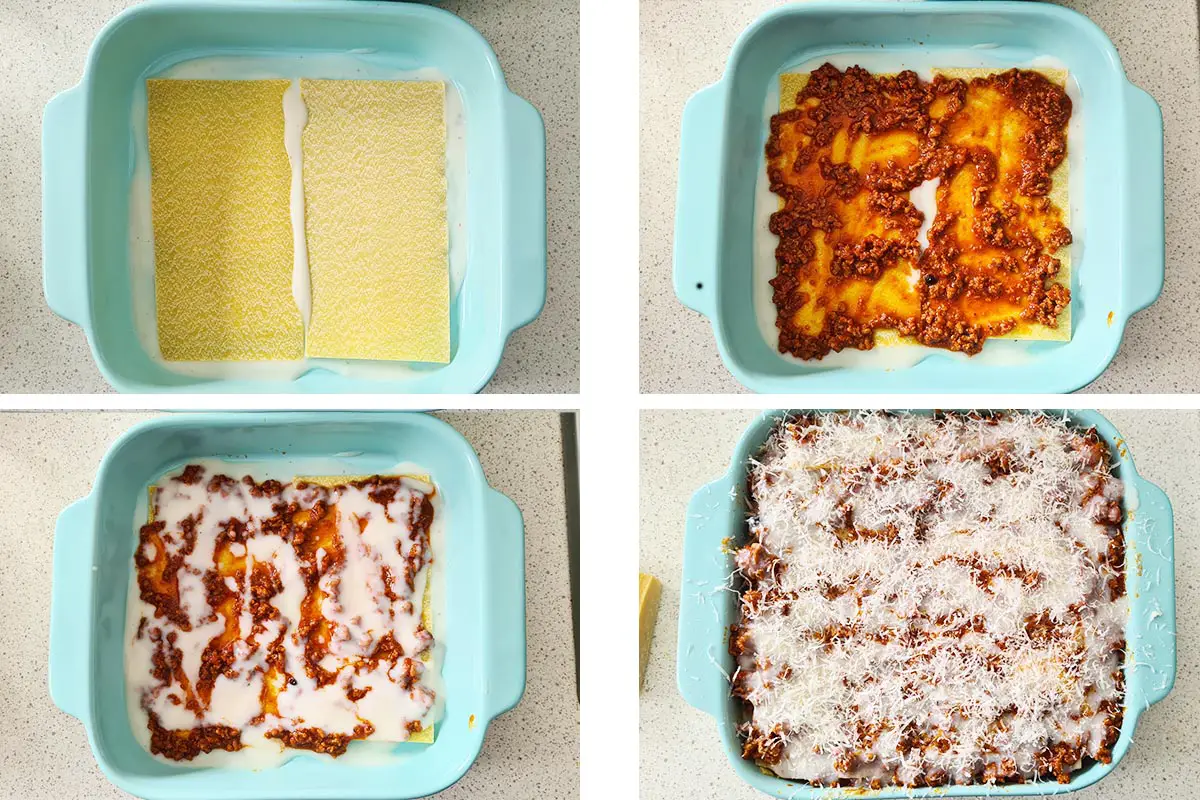
Assembly: You should always cover the bottom of the pan with a layer of sauce (doesn't matter which one) before you add the pasta, this will prevent the pasta from sticking to the pan. And always finish the top with a generous layer of grated Parmigiano cheese to achieve a golden crust. Each layer should be Pasta, Ragù, Béchamel, and Parmesan.
Storage
You can keep leftovers in an airtight container in the fridge for 2-3 days. You can also freeze leftovers for up to 3 months. Thaw in the fridge overnight and reheat in the microwave or in the oven.
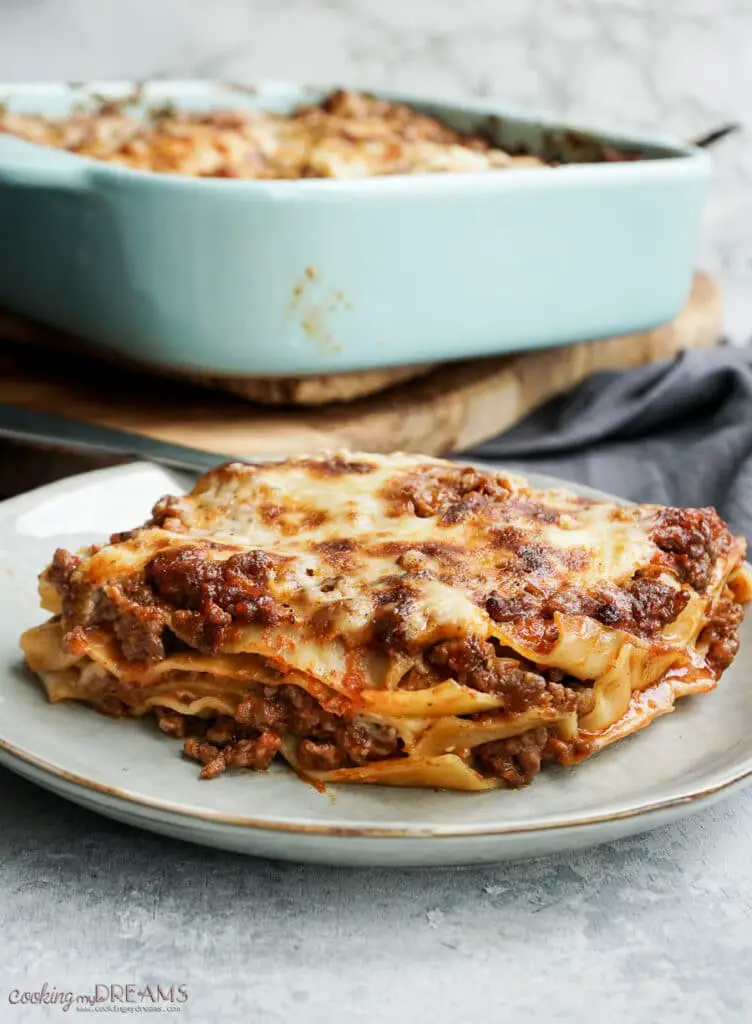
FAQ & Tips
Yes, you can make this Lasagna up to 1 day in advance. Assemble it in the baking dish, then cover it with cling foil and store it in the fridge. Take it out of the fridge at least 1 hour before baking, then follow the normal baking instructions
Sure, if you don't have much time and want to cut corners, you can obviously substitute the Tuscan Ragù with your favorite good quality jarred Bolognese sauce and the same goes for the Béchamel or white sauce as it's often called.
I never pre-boil the dried pasta but I make sure there is plenty of sauce on each layer to make sure the pasta will cook fine and evenly in the oven. If your white sauce and ragù are too thick, consider diluting them with water/milk before assembling the Lasagna. If you want to be 100% sure the pasta will cook, you can also boil the pasta 2-3 minutes before assembling the Lasagna.
Related recipes you might like
If you like this recipe, try also these other Lasagna recipes:
If you tried this recipe, please take a moment to rate it and share your thoughts in the comments. Your feedback means a lot to me! ★★★★★
📖 RECIPE
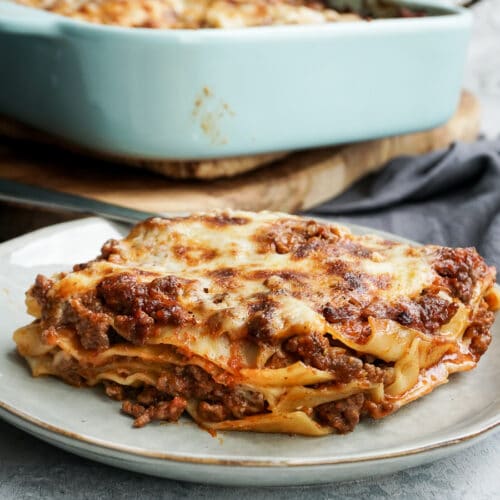
Classic Tuscan Lasagna
Ingredients
- 3 lbs Tuscan Ragù, see notes
- 1 package Lasagna sheets, about 4 portions of fresh pasta
- 2 cups Parmigiano cheese, grated
For the Béchamel sauce:
- 4 cups Milk
- ½ cup Butter
- ½ cup Flour
- Salt
- Black Pepper
- Nutmeg, ground
Instructions
Prepare the Bechamel:
- In a pot, melt the butter and add the flour. Mix until you get a paste and cook it for a minute or two until it gets thicker.
- Add the room temperature or warm milk and turn down the heat. Mix occasionally, to melt the roux and to make sure it doesn’t stick to the pot.
- Let it simmer for 15-20 minutes until it gets thick enough to coat a spoon, then season with salt, black pepper and a pinch of ground nutmeg to taste.
Assemble the layers:
- Preheat the oven at 200°C (400°F).
- Spread a thin layer of white sauce on the bottom of the pan, cover with a layer of pasta, then a layer of Ragù sauce, a layer of bechamel sauce and grated Parmigiano.
- Repeat the layers, pressing down a little bit when you add the pasta. When the pan is full, finish with a last layer of pasta, sauce and a generous amount of grated Parmigiano cheese.
- Bake in the middle rack of the oven for about 35-40 minutes. If the crust is not crunchy enough, finish with 3-4 minutes under the broiler. If instead you notice the crust getting too brown before the cooking time is over, cover the pan loosely with foil.
Notes
- Tuscan Ragù: Check the full recipe for Tuscan Ragù sauce. You can make the ragù the day before to have it ready for the Lasagna.
Nutrition
Nutritional information is only an estimate. The accuracy of the nutritional information for any recipe on this site is not guaranteed.


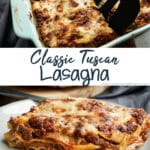

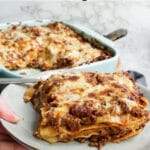

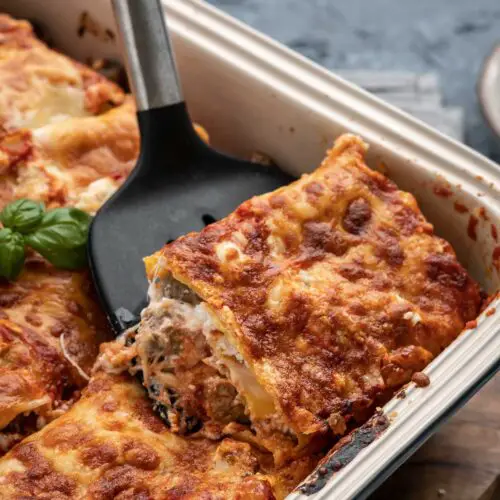
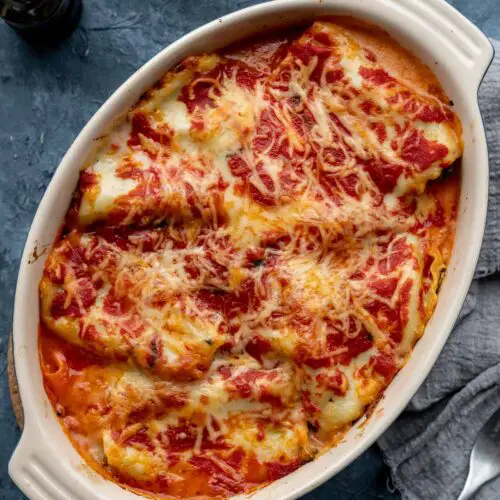
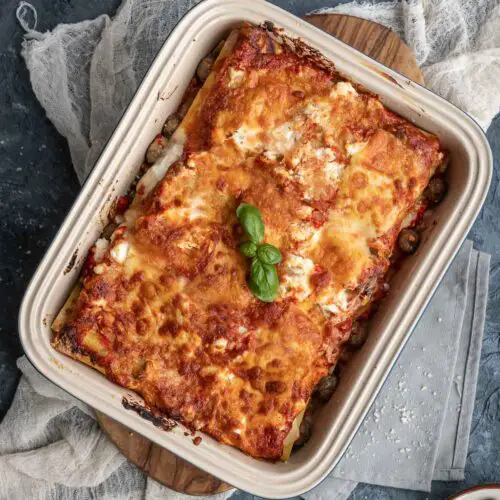

Savana
I first discovered Northern Italian Lasagna in Florence and I LOVED IT. I never liked lasagna that much before then because I am not a fan of ricotta cheese (I know, RIP cannoli fans). I didn’t know what the white sauce was for a few years, and I never realized Northern Italy would have a different recipe style than Southern Italy. After learning more about the cuisine of Italy, I understand that the availability of ingredients and cross-cultural influence of France in Northern Italy inspired much of their traditional recipes, including lasagna!
This recipe is the best that I have tried since that first Florentine lasagna. It’s also very hard to mess it up. I use the Tuscan Ragú recipe that is mentioned as well and it is so very good. This is a recipe I will make over and over again. Thank you SO MUCH for sharing and making the recipe so easy to follow.
Hi Savana, Thank you so much for your feedback! I'm so glad you enjoyed it! 🙂
Val Miller
I just returned from a month stay in Tuscany and had the northern style lasagna twice while there. Hands down the best lasagna I’d ever had so I was excited to try this recipe. It did not disappoint! Yes, making the Ragu is a bit of work, but double the recipe and then you’re all set for the next time. I wouldn’t change a thing in this recipe, it was perfect. Draining off the grease from the meat is a must, quite a lot is generated. Juniper berries were easy to find at my local Penzey’s Spices store. This recipe is a winner and the instructions were easy to follow.
Hi Val, thank you so much for your comment! I'm so happy you enjoyed it! 🙂 🙂
Annette
We just returned fr9m Italy, where we had the lightest cloud like lasagna we ever ate. Our friends told us it had bechemel sauce, something i never heard of. I was taught by a Southern Italian Nonna. But i am going to try this one!
Hi Annette, Yes northern Lasagna is all about bèchamel. 🙂 I hope you'll like it!
Lori Cogen
My husband and I visited Tuscany in June and loved the lasagna there! I was determined to try and replicate it...and then I found yours. This is now the third time I'm making it and I want to thank you so much. It i really delicious! I used Barilla noodles, the first time and then homemade sheets from Doris's Italian market the second, and this, time. Again, thank you!
Thank you so much Lori for your feedback, I'm so glad you enjoyed it as much as I do! 🙂
Charles DEMING
Sorry, one more question: So that I will be able to apportion my noodles, sauces and layers properly, what size pan would you recommend?
I used a 9-inch square pan for this recipe. You can also use an 11x8-inch pan.
Chuck Deming
Our favorite pasta when visiting the Tuscany region was a lasagna at a place in Florence, and I haven't been able to replicate it. I hope your recipe corrects that.
Can I assume the Italian sausage is cut open and mixed with the beef and pork before cooking? Do I drain the grease from the meat after cooking and before the other ingredients are added?
Hi Chuck, Yes the sausage should be removed from the casing when added to the meat. I will clarify this in the recipe as well. 🙂 I usually do not drain the grease as there is not so much, but feel free to do so if you feel it's too greasy.
Barbara Gallagher
I love, love, love this recipe! It’s the only way I make lasagna now. I modified the Tuscan ragu recipe to make it a bit meatier but it’s otherwise same. The juniper berries give the sauce a wonderful earthy flavor. I also use an Ina Garten trick with packaged lasagna noodles: soak for 20 minutes in hot water instead of cooking. This keeps them firm and Al dente when baking the lasagna. I’ve made this recipe a number of times and always get compliments. Thanks for a great recipe!
Thank you so much Barbara for your comment! I'm so happy you love this as much as I do.
I didn't know the Ina Garten trick and I'll definitely use it next time, thanks! 🙂
Debbie
I haven't tried the recipe yet (but will) You have all the interesting information that is needed.
I have never made Lasagna even though I love it and am a good cook.
I got some Lasagna from my daughter and didn't think it was quite right and started exploring. You explain everything I needed to know! Especially about the pasta..not fitting!! Maybe I'll even try making pasta too!
Thank you for explaining all about Lasagna!!
I also really like all the different varieties you list too! Since I'm 70 and been cooking for awhile..I can tell this recipe is GREAT! I better get cooking!
Hi Debbie, Thank you so much for your feedback! I hope you'll make this Lasagna and love it as much as we do! Have a great day!